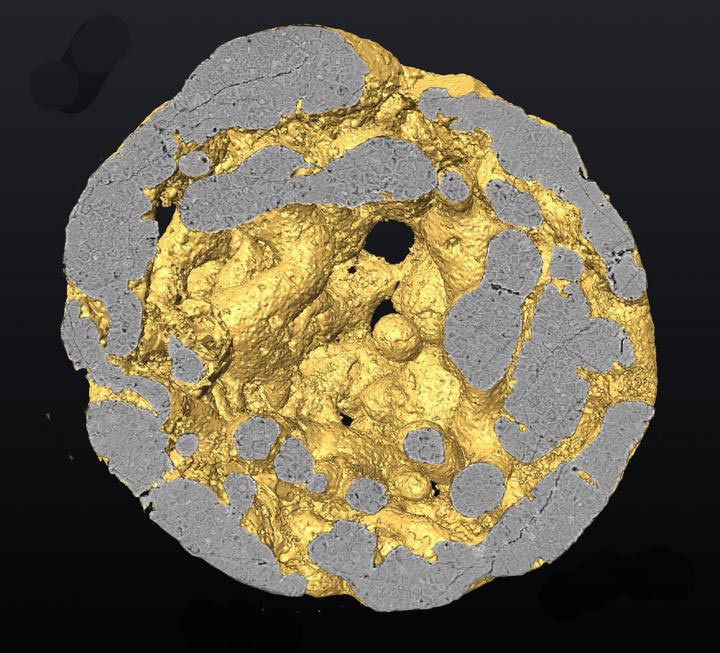Researchers say animal-like embryos preceded animal appearance

Three-dimensional reconstruction of a Caveasphaera specimen, showing cell structures. Credit: NIGPAS
The research – by an international research team led by scientists from the Nanjing Institute of Geology and Palaeontology of the Chinese Academy of Sciences (NIGPAS) and the University of Bristol – focused on ancient fossils of Caveasphaera, a multicellular organism found in 609-million-year-old rocks in South China's Guizhou Province that defies easy definition as animal or non-animal.
Using X-ray microscopy, the researchers analyzed the tiny fossils, which measure about a half-millimeter in diameter and were preserved down to their component cells. Various fossils displayed different stages of Caveasphaera development – from a single cell to a multicellular organism.
“We were able to sort the fossils into growth stages, reconstructing the embryology of Caveasphaera,” said Kelly Vargas from the University of Bristol.
YIN Zongjun of NIGPAS interpreted the discovery: “Our results show that Caveasphaera sorted its cells during embryo development in just the same way as living animals, including humans.” YIN emphasized, however, there is “no evidence that these embryos developed into more complex organisms.”
Still, the discovery offers the earliest evidence of a key step in the evolution of animals – the capacity to develop distinct tissue layers and organs.
The verdict still seems to be out on whether Caveasphaera was itself an animal or just an important step in animal evolution, even as researchers search for more fossils. Co-author ZHU Maoyan of NIGPAS said, “Caveasphaera looks a lot like the embryos of some starfish and corals – we don't find the adult stages simply because they are harder to fossilize.”
Whatever Caveasphaera turns out to be, its fossils tell us that animal-like embryonic development evolved long before the oldest definitive animals appeared in the fossil record.
###
This research was funded through the Biosphere Evolution, Transitions and Resilience (BETR) programme, which is co-funded by the UK's Natural Environment Research Council (NERC) and the Natural Science Foundation of China (NSFC).
Media Contact
All latest news from the category: Life Sciences and Chemistry
Articles and reports from the Life Sciences and chemistry area deal with applied and basic research into modern biology, chemistry and human medicine.
Valuable information can be found on a range of life sciences fields including bacteriology, biochemistry, bionics, bioinformatics, biophysics, biotechnology, genetics, geobotany, human biology, marine biology, microbiology, molecular biology, cellular biology, zoology, bioinorganic chemistry, microchemistry and environmental chemistry.
Newest articles

Superradiant atoms could push the boundaries of how precisely time can be measured
Superradiant atoms can help us measure time more precisely than ever. In a new study, researchers from the University of Copenhagen present a new method for measuring the time interval,…

Ion thermoelectric conversion devices for near room temperature
The electrode sheet of the thermoelectric device consists of ionic hydrogel, which is sandwiched between the electrodes to form, and the Prussian blue on the electrode undergoes a redox reaction…

Zap Energy achieves 37-million-degree temperatures in a compact device
New publication reports record electron temperatures for a small-scale, sheared-flow-stabilized Z-pinch fusion device. In the nine decades since humans first produced fusion reactions, only a few fusion technologies have demonstrated…





















